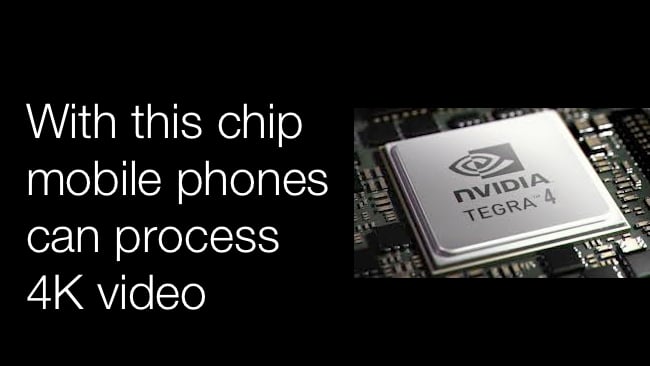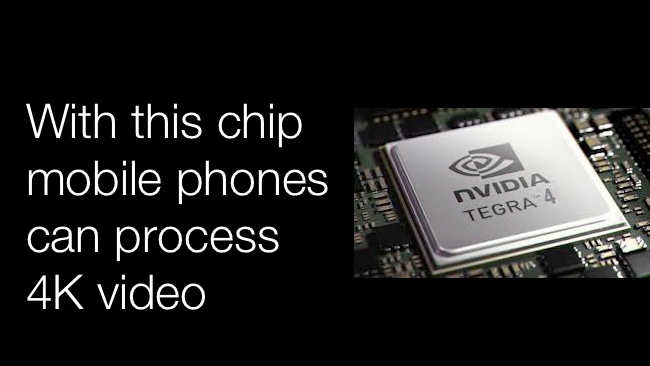
 Tegra 4
Tegra 4
Just in case anyone was in doubt that the 4K revolution is happening, Nvidia has just announced that its much anticipated Tegra 4 mobile chipset will include "4K Ultra-High-Def video support"
The Tegra 4 is significant because it has six times the GPU horsepower of the Tegra 3, and also incorporates ARM's most advanced CPU core, the Cortex A15. Just a few days ago, we predicted that ARM was going to be a technology to watch this year.
The new chipset will obviously be used in mobile platforms, from phones to tablets, and quite possibly games controllers and consoles, and the raw video processing power is unmatched in what is already a feverishly active area for technical innovation.
Computational Photography
One example of the Tegra 4's prowess is that it has a "Computational Photography Architecture" which "automatically delivers high dynamic range (HDR) photos and video by fusing together the processing power of the GPU, CPU and the camera's image-signal processor".
Quite what use the 4K processing will be put to we will have to see, but don't forget that "retina" resolution displays are now common in recent mobile devices, and with 4K support now offered in state-of-the-art mobile ARM-based chips, the day when we see 4K resolution in a portable device is edging closer. And with 4K processing power soon to be available, it is surely inconceivable next generation of games consoles (or should we say "home media hubs") will not have a 4K output.
Update
We've just heard that Nvidia has just announced the world's first games console that will have a 4K output though HDMI (according to The Verge). Called "Project Shield", it has a 5 inch multitouch display, attached to a handheld controller. As far as we know, it will also be the first Android device with a 4K output.
This is an astonishing development, because we were expecting the still-to-be-announced Sony Playstation 4 to be the first gaming console with a 4K output.
With all of this going on, and with such abundant processing power available in mobile chipsets, you have to wonder whetherTegra 4-type chipsets will start to appear in camcorders and other professional video devices, just as the Playstation 3's chipset found its way into professional equipment like Sony's 3D processor.
You can see how this could happen. Just take a commercially available Tegra 4 development board, add a 4K sensor...
Here's Nvidia's press release in full
NVIDIA Introduces World's Fastest Mobile Processor Tegra 4 Features 72 Custom GPU Cores, Quad-Core Cortex-A15 CPU for Superb Performance and Efficiency; LTE Enabled with Optional Chipset LAS VEGAS-CES-Jan. 6, 2013-NVIDIA today introduced NVIDIA® Tegra® 4 , the world's fastest mobile processor, with record-setting performance and battery life to flawlessly power smartphones and tablets, gaming devices, auto infotainment and navigation systems, and PCs. Tegra 4 offers exceptional graphics processing, with lightning-fast web browsing, stunning visuals and new camera capabilities through computational photography. Previously codenamed "Wayne," Tegra 4 features 72 custom NVIDIA GeForce™ GPU cores – or six times the GPU horsepower of Tegra 3 – which deliver more realistic gaming experiences and higher resolution displays. It includes the first quad-core application of ARM's most advanced CPU core, the Cortex-A15, which delivers 2.6x faster web browsing and breakthrough performance for apps.
Tegra 4 also enables worldwide 4G LTE voice and data support through an optional chipset, the fifth-generation NVIDIA Icera® i500 processor. More efficient and 40 percent the size of conventional modems, i500 delivers four times the processing capability of its predecessor. "Tegra 4 provides enormous processing power and efficiency to power smartphones and tablets, gaming devices, auto systems and PCs," said Phil Carmack, senior vice president of the Tegra business at NVIDIA. "Its new capabilities, particularly in the area of computational photography, will help improve a whole range of existing products and lead to the creation of exciting new ones."
Computational Photography Capability Among the Tegra 4 processor's breakthroughs is its Computational Photography Architecture, which automatically delivers high dynamic range (HDR) photos and video by fusing together the processing power of the GPU, CPU and the camera's image-signal processor. Its HDR capability captures images, including those taken with a flash, the way they are seen by the human eye – with detail in both bright and dark areas. Unprecedented Power Efficiency Designed for maximum energy efficiency, Tegra 4 includes a second-generation battery saver core for low power during standard use, and PRISM 2 Display technology to reduce backlight power while delivering superior visuals. Tegra 4 consumes up to 45 percent less power than its predecessor, Tegra 3, in common use cases. And it enables up to 14 hours of HD video playback on phones. Tegra 4 Key Features · - GeForce GPU with 72 custom cores · - Quad-core ARM Cortex-A15 CPU, plus a 2nd Generation Battery Saver Core · - Computational Photography Architecture · - LTE capability with optional Icera i500 chipset · - 4K ultra-high-def video support
Tags: Technology


Comments